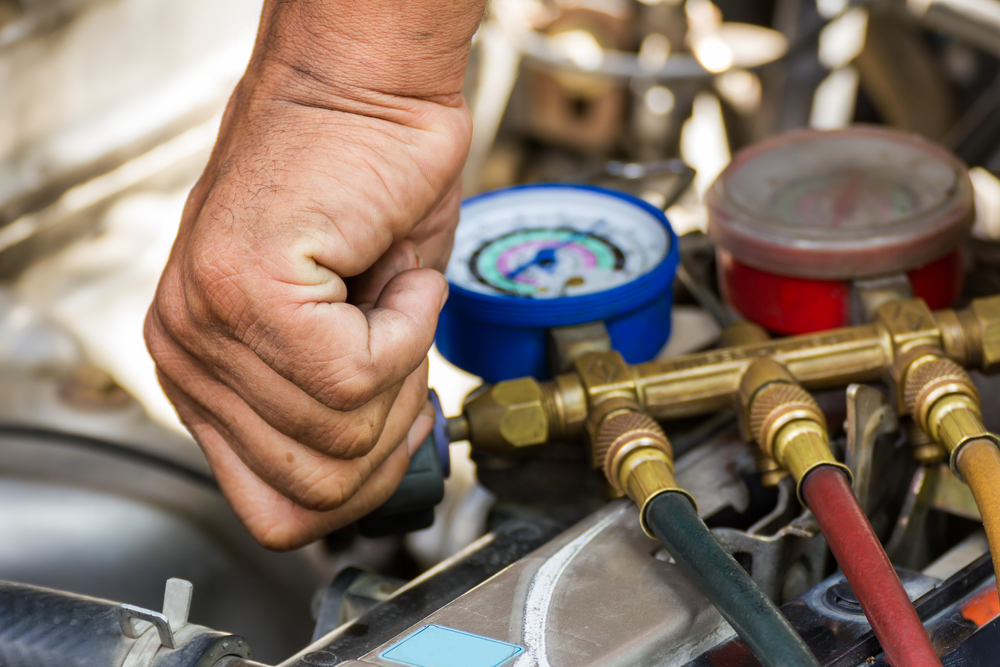WHAT IS AN AIR COMPRESSOR?
An air compressor’s main function is to convert electric power into pressurised air. When air is compressed, it becomes stronger, making it useful for different workshop applications or to power tools.
In an air compressor, air is stored under pressure. This compression creates energy which can be utilised to power pneumatic tools. Air compressors work by absorbing and circulating air, filtering it, and then returning it to the outlet at the desired pressure.
Compared to using a centralised power source, air compressors are much smaller in size and don’t require a massive motor to run. They’re also highly portable, quieter and more durable. Nearly all air compressors are powered by an electric motor or gas engine.
Today, air compressors are used anywhere where products are assembled and serviced, such as workshops, factories, auto mechanics or petrol stations and at home. By understanding how an air compressor works, you can better determine the right air compressor for the job. Here’s what you need to know!
What Are the Main Parts of an Air Compressor?
The basic components are:
Drive
There are two types of drives – belt-driven or direct drive. A belt drive uses a moving belt to activate the system’s pump. In a direct drive system, the motor is attached directly to the crankshaft of the compressor. A belt drive is the most economical option whereas direct drive systems allow for smaller designs and fewer maintenance requirements.
Pump
A pump uses the energy from the drive to absorb and compress the air, which is then sent through a tube into the storage tank.
Storage Tank
Storage tanks serve as temporary storage by enabling you to use air when the compressor is not running. They also supply additional air to the system during periods of high usage. Storage tanks are equipped with a one-way valve (check valve) to stop compressed air from putting pressure on the pump. It acts as a butter to eliminate wear and tear to the pump and motor from continuous running.
HOW TO USE AN AIR COMPRESSOR
Understanding how to use an air compressor begins with ensuring your safety and the safety of those around you. Prior to operating, one must read the manufacturer’s manual meticulously to familiarise yourself with the specifics of your model. Make sure to inspect the oil and fuel levels and ensure they are at optimum levels. Following this, connect the hose to the air compressor securely, fitting the other end with the appropriate tool, making certain that the connection is tight to avoid any air leakage. Adjusting the pressure regulator to match the tool’s PSI requirement is crucial. Once everything is in place, power on the compressor and allow the tank to fill with compressed air. It is vital to operate the compressor in well-ventilated areas and never exceed the recommended pressure levels as it may lead to hazardous situations. Occasionally, drain the tank of any accumulated moisture to maintain the compressor’s efficiency and longevity. It’s equally important to switch off and unplug the compressor when not in use and store it in a dry, clean environment.
HOW DOES AN AIR COMPRESSOR WORK?
To use an air compressor optimally, it’s important to understand how it operates. Essentially, the compressor absorbs air, which is then filtered and pressurised within the storage tank, ready to be utilised. The energy, created due to air compression, is used to work pneumatic tools. The efficiency of an air compressor is significantly notable as they are portable, quieter, and more durable compared to centralised power sources, and they don’t need a massive motor to function. Knowing how an air compressor works, helps you determine the most suitable compressor for various jobs, assuring the achievement of high-quality results in diverse applications such as in workshops, factories, and petrol stations, to mention a few.
What is a Rotary Screw Air Compressor?
Rotary screw air compressors are the most commonly used type of air compressor.
These machines have two interlocking helical rotors, male and female, which rotate in opposite directions to draw air in between them.
Air is then trapped between the rotors. As the screws turn, the pressure of the air increases as the space between the rotors decreases. The speed of this process can be adjusted according to the application in variable speed drive rotary compressors.
Rotary screw air compressors can also come with one screw. However, single-screw rotary types are rarely used for compressing air, as they’re seen more in refrigerant applications.
Best Uses
Designed for heavy-duty applications and can work at high speeds and large flow rates. If there’s a high demand for air in your workshop, rotary screw compressors can keep up without wasting energy or creating unnecessary noise.
What is the Difference Between Oil Free & Oil Lubricated Air Compressors?
Rotary screw compressors can either be oil-lubricated or oil-free.
Oil-lubricated compressors work by bathing the walls and bearings within the cylinder with oil. The oil also provides a hydraulic seal between the rotors to transfer mechanical energy.
In oil-free air compressors, male and female rotaries are controlled by timing gears to ensure they maintain alignment. These gears and their bearings need oil to work and are treated with lasting lubrication.
Whilst there is oil in an oil-free air compressor, the difference is that it’s separated from the compressed air side, making applications oil-free. The compression is done without oil, only air, enabling oil-free air compressors to be utilised in hospitals and within the food industry as there is no risk of oil contamination.
What is a Piston Air Compressor?
Piston air compressors are oil lubricated. They work by using the tool’s crankshaft to force air into the compression chamber. The crankshaft drives the piston closed before pushing the compressed air into the storage tank. As the piston opens again, more air is drawn into the tank.
Reciprocating piston air compressors contain the following parts:
- Crankshaft
- Piston
- Cylinder
- Connecting Rod
- Valve Head
There are two types of piston compressors, single-stage and dual. Single-stage uses a piston to compress the air in one stroke, a full rotation of the crankshaft. Dual-piston air compressors have two stages. The compressor uses one piston to compress air in a single stroke, before moving that compressed air to a smaller cylinder for a second stroke from a second piston, doubling the air pressure stored in the tank.
Contact the Air Compressor Experts
Express Compressors offer quality Australian air compressors and air dryer products that are specifically engineered for the Australian environment, so you know your compressed air equipment is built tough and will be guaranteed to perform under Australian conditions. If you would like more information about what air compressor would suit you, contact our team for expert advice.






 Ingersoll Rand 37952355 Compressor Temperature Sensor Kit Genuine OEM
Ingersoll Rand 37952355 Compressor Temperature Sensor Kit Genuine OEM  Gardner Denver ZS1128464 Air Oil Separator Equivalent
Gardner Denver ZS1128464 Air Oil Separator Equivalent